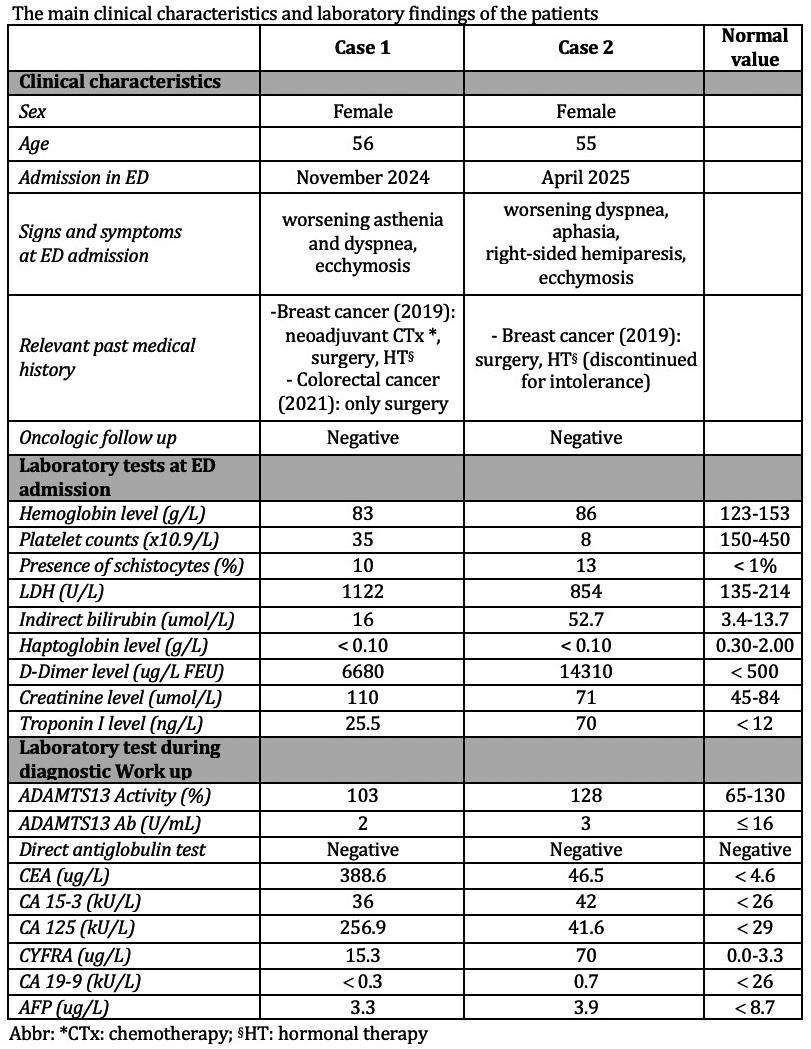Abstracts from the 29^ National Conference of the Italian Society for the Study of Hemostasis and Thrombosis, Bergamo, Italy | 23-25 October 2025
Vol. 4 No. s1 (2025)
PO34 | A negative oncologic follow up doesn’t always really mean no cancer: two case report of cancer-associated thrombotic microangiopathy
E. Cosi, A. Bertomoro, G. Bogoni, I. Bertozzi, I. Cortella, P. Simioni | Clinica Medica ORI, Azienda Ospedale-Università Padova, DIDAS, Italy
Publisher's note
All claims expressed in this article are solely those of the authors and do not necessarily represent those of their affiliated organizations, or those of the publisher, the editors and the reviewers. Any product that may be evaluated in this article or claim that may be made by its manufacturer is not guaranteed or endorsed by the publisher.
All claims expressed in this article are solely those of the authors and do not necessarily represent those of their affiliated organizations, or those of the publisher, the editors and the reviewers. Any product that may be evaluated in this article or claim that may be made by its manufacturer is not guaranteed or endorsed by the publisher.
Published: 22 October 2025
374
Views
0
Downloads
Similar Articles
- PO24 | Emicizumab prophylaxis and bleeding outcomes: a single center clinical experience , Bleeding, Thrombosis and Vascular Biology: Vol. 4 No. s1 (2025)
- PO53 | Effectiveness and safety of DOACS in patients with renal transplantation , Bleeding, Thrombosis and Vascular Biology: Vol. 4 No. s1 (2025)
- PO85 | Acute retinal ischemia in hemoglobin SC disease: a case report and review of the literature , Bleeding, Thrombosis and Vascular Biology: Vol. 4 No. s1 (2025)
- PO25 | Baseline thrombin generation test does not predict thrombotic events in acute leukemia: a monocentric prospective study , Bleeding, Thrombosis and Vascular Biology: Vol. 4 No. s1 (2025)
- PO54 | Resolvin response in bronchial asthma patients: endotype and clinical severity , Bleeding, Thrombosis and Vascular Biology: Vol. 4 No. s1 (2025)
- PO86 | Emicizumab in patients with moderate hemophilia A and severe bleeding phenotype: single-center real-world experience , Bleeding, Thrombosis and Vascular Biology: Vol. 4 No. s1 (2025)
- PO26 | Non-canonical coagulation platelets function: monocyte-platelet interaction a bridge between inflammation and coagulation , Bleeding, Thrombosis and Vascular Biology: Vol. 4 No. s1 (2025)
- PO55 | Evaluation of safety and efficacy of emicizumab prophylaxis in pediatric patients with hemophilia A – a single centre experience , Bleeding, Thrombosis and Vascular Biology: Vol. 4 No. s1 (2025)
- PO87 | Intravascular leiomyomatosis extending to the right atrium: a case report with a multidisciplinary management , Bleeding, Thrombosis and Vascular Biology: Vol. 4 No. s1 (2025)
- PO27 | B-cell lymphoproliferative disorder and acquired coagulopathy: an insidious link , Bleeding, Thrombosis and Vascular Biology: Vol. 4 No. s1 (2025)
1-10 of 96
Next
You may also start an advanced similarity search for this article.











